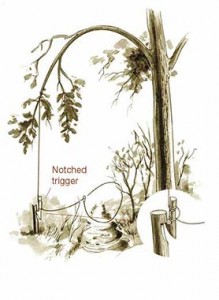
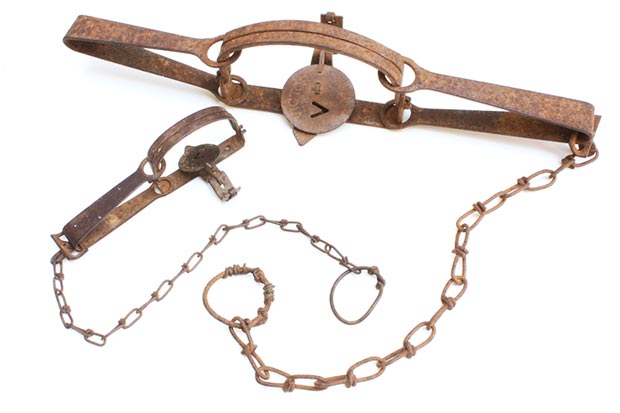
In a real life survival situation, knowing how to live off the land may be crucial for you and your family. Along with shelter, fire and water, food is one of those things we’re all dependent upon, hence the fine art of hunting has been practiced by humans since time immemorial.
All ancient cultures had a cult for hunting and one of the best methods of putting meat on the table whilst conserving your time and your energy is to hunt with traps and snares.
The best thing about traps as survival tools is that you can build them on the spot, and they don’t require specialized equipment since they’re improvised (think guerilla warfare). Also, they work 24/7 by themselves and unsupervised, so you can do other things while hunting with traps, like sleeping, gathering wood, or whatever else is needed.
Traps can be defined as a survivalist’s secret weapon. A trap is not as flashy and bad-ass looking when compared to a tactical knife, but it’s one of the most reliable and effective tools for gathering food off the land. In a survival situation, hunting small game with traps and snares is the best option.
Small game is abundant in almost all areas, in wilderness or near/inside the cities. There are a few proven methods that work when hunting small mammals, rodents, birds or waterfowl.
In short, a trap/snare device works by choking , crushing or entangling the animals you’re targeting. When building a trap or a snare, you must keep it as simple as possible – nothing fancy. Practicality and efficiency is the name of the game.
Small Game to Hunt
The first step is to determine what kind of animal you’re trying to catch because there are different trapping methods for different species. There are no “one size fits all” kind of traps.
Usually, small game consists of rabbit, squirrel, dove, chipmunk, packrat, mice, raccoon, beaver, fish etc; basically any living thing that crawls, flies or swims and is made of meat is fair game. When you’re in a survival situation, you can’t afford the luxury of being picky about your food.
A hard-core prepper should be aware of the animals available in his/hers area and have knowledge about their habitat, their habits, their mating cycles and what they eat. Knowing what kind of tracks they leave is also beneficial. Like Sun Tzu said in The Art of War, “Know your enemy, 100 battles, 100 victories.”
The Traps
Next, you must know how to build a trap or a snare. There are a few basic types of traps that work on almost all small game species.

1. The simple snare trap consists of a noose that is placed over a trail or a den hole and connected to a stake. The noose must be large enough to allow the animal’s head to pass through; as the “victim’s” head moves through the snare, the noose will tighten around its neck and as the animal fights to get loose, the snare will strangle it.
It sounds very simple, but it’s extremely effective in the right situations.
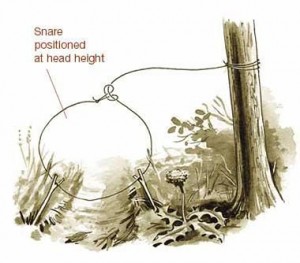
You can improve your chance of success by baiting the trap, thus drawing the animal towards it. As bait, you should use a food source that is not abundant in the area, yet the animal is familiar with.
Using bait when fishing isn’t an option if you want to catch one. A great bait for small mammals is peanut butter (from a MRE ration for example). When using bait, you can use “samples” to attract the animal’s attention, by scattering little bits around the trap.
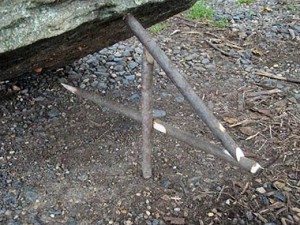
2. Another classic trap in the field is the figure-four dead fall.
This trap uses a trigger in order to drop a heavy object over the animal.
The object must be heavy enough to kill the target upon impact.
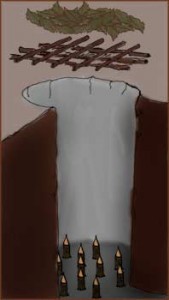
3. The Dead Fall Pit works on small, medium and large animals.
The only bad thing is that it requires a great amount of energy to build it, but it is very efficient.
You must first find a game trail and then you should dig the pit near it. When you consider the pit deep enough to hold the game inside it, you must place sharpened sticks at the bottom and then build a grill from sticks and branches to cover the hole.
Use leaves and grass to cover the grill and you’re ready to go.
Tips for Using Traps
These are some of the most used and easy to build traps and snares. A few things to consider when using them:
Now that you have some ideas about the different types of traps, you’re a little better prepared to survive in the case of a SHTF scenario.
Please feel free to comment below if you have questions, suggestions, or something great to add!

This article has been written by Chris Black for Survivopedia.
Chris Black is a born and bred survivalist. He used to work as a contractor for an intelligence service but now he is retired and living off the grid, as humanly possible. An internet addict and a gun enthusiast, a libertarian with a soft spot for the bill of rights and the Constitution, a free market idealist, he doesn't seem very well adjusted for the modern world. You can send Chris a message at editor [at] survivopedia.com.